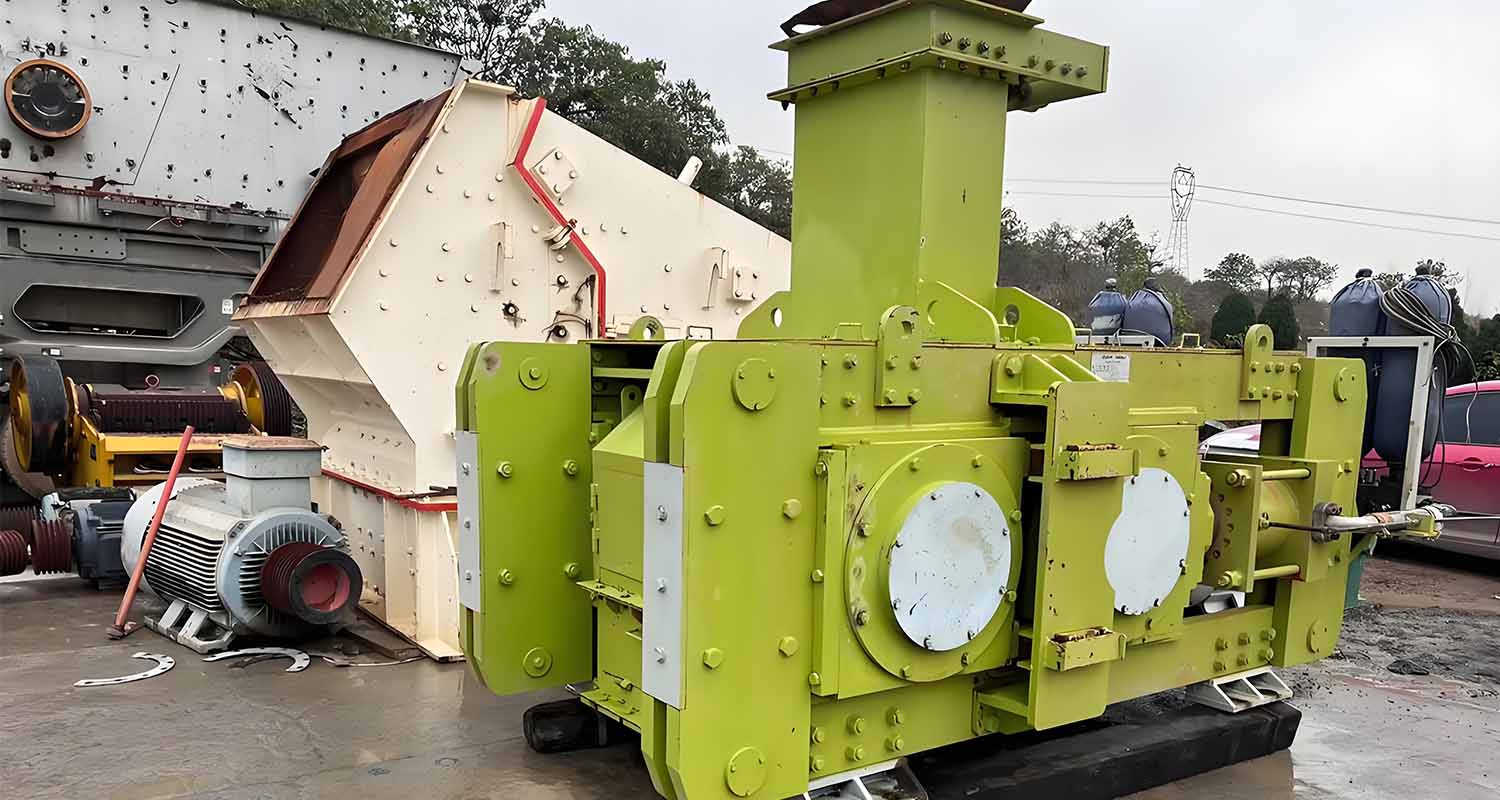セメント生産において、ローラープレスは重要な設備であり、その稼働の安定性は生産効率と製品品質に直結する。以下は、T社、J社、S社の故障対応に関する具体的な事例と経験の共有です。設備運転中に同様の問題が発生した場合は、お気軽に下記までご連絡ください。 お問い合わせ で ダーコ.この分野での専門家の才能と、良い経験に頼って、我々は偉大な成果を取得し、最高のメーカーの一つとして関係しているTaiwan。

セメント工場A 異常状況説明
断層現象
セメント工場Aでは、ローラープレスと計量サイロの間に垂直の供給パイプを使用している。しかし、このパイプは短すぎる。その結果、ローラープレスの作動圧力が低くなり、押し出し能力が低下する。その結果、供給材料は篩い残りが多く、微粉含有率が低くなる。このような状況は、低いシステム収率と高い粉砕エネルギー消費につながる。
システム構成
- ローラープレス: 120-50ローラープレス(材料処理量165t/h、主電動機出力250kW、電流21A×2)
- 分散・分級機 550/120(処理能力140-175t/h、モーター出力45kW+30kW)
- チューブミル Φ3.2×13m3室オープンサーキット式チューブミル(主電動機出力1600kW、粉砕媒体負荷127t)
- 集塵ファン: オープンサーキット複合粉砕システム
結果
このシステムは、少なくとも380±10m²/kgの比表面積を持つP.O42.5等級のセメントを生産する。35kWh/tのエネルギーを消費しながら、65t/hの収率を達成する。しかし、供給原料のR80μm残渣は78.7%に達し、原料のうち微粉は21.3%に過ぎない。このため、出来上がったセメントには粗い粒子が多く含まれる。
技術診断分析
ローラープレスと計量サイロ間の垂直供給パイプの高さが1.2m未満であるため、パイプ内の材料圧力が低く、ロッドバルブの頻繁な調整が必要である。計量サイロでは、材料の偏析や崩落が頻繁に発生し、生産エリアでは大きな粉塵が発生する。ローラープレスの使用圧力が6.0-6.5MPaしかなく、材料の押出効果に直接影響する。
技術的対策と効果
年次オーバーホールでは、エレベーターと計量サイロの高さを上げ、垂直供給パイプの高さを2.5mに引き上げました。ローラープレスの側板を肉盛溶接で補修し、漏れを減らしました。計量サイロの原料レベルを60%-70%に維持することで、偏析と原料崩れを解消しました。ローラープレスの作動圧力を7.2-7.5MPaに調整し、供給原料のR80μm残渣を49.8%に低減しました(微粉含有量は50.2%に達しました)。システム収率は79t/hに増加し、粉砕エネルギー消費量は26.4kWh/tに減少しました。年間480万kWhの電力を節約でき、280万人民元の経済効果があります。
セメント工場B 異常状況の説明
断層現象
セメント工場Bでは、オペレーターはローラープレスへの供給制御が不安定であることに直面していた。この不安定さは作業能力を低下させる。その結果、メインモーターの出力が不足する。その結果、供給原料の微粉含有率が低くなる。結局、この状況は低い歩留まりと高い粉砕エネルギー消費につながります。
研削システム構成
- ローラープレス: 170-100ローラープレス(材料処理能力620t/h、主電動機出力900kW)
- クラシファイア: Vx8820
- チューブミル φ4.2×13mダブルチャンバーチューブミル(主電動機出力3550kW)
- 集塵ファン: 二重閉回路複合粉砕システム
結果
このシステムは、P.O42.5等級のセメントを165t/hの歩留まりで生産し(仕上がり繊度R45μmの残渣9.0±1.0%)、粉砕エネルギー消費量は44kWh/tに達する。
技術診断分析
ローラープレスへの供給が不安定なため、押出能力が低く、モーター出力も不十分で、運転電流は42%~45%しかない。供給材料の比表面積は約160m²/kgである。
技術的対策と効果
某技術会社の特許技術「ローラープレス用レバー式二重送り装置」を採用し、送り制御を安定させ、メインモーター出力を72%-78%にアップ。また、内部構造の改善により、出力中の完成品比率を向上。最終的に、P.O42.5等級のセメントのシステム収量は210t/hに達し、粉砕エネルギー消費量は38.1kWh/tに減少し、13.41%の省エネを達成しました。システム動力を最適化した後、生産効率は大幅に改善されました。
セメント工場C 異常状況の説明
断層現象
セメントプラントCでは、粒径の小さいフライアッシュと脱硫石膏の両方が一緒に計量サイロに入ります。脱硫石膏の含水率が高いため、サイロの壁に材料がひどく付着し、ローラープレスの出力とシステム全体の歩留まりに影響を与えます。
研削システム構成
- ローラープレス: 120-50ローラープレス(材料処理能力165t/h、主電動機出力250kW)
- 分散・分級機 550/120
- チューブミル Φ3.2×13m3室式チューブミル(主電動機出力1600kW)
- 集塵ファン: オープンサーキット複合粉砕システム
結果
このシステムは、P.O42.5等級のセメントを65t/hの歩留まりで製造し(完成比表面積≥360±10m²/kg)、粉砕エネルギー消費量は33kWh/tである。供給原料のR80μm残渣は65%以上(80μm未満の微粉は35%前後)。
技術診断分析
粉状の材料がローラープレスの押し出し能力に影響を与え、運転電流が低下する。計量サイロでは、高い含水率により材料の付着が激しくなり、供給パイプ内の材料の流れに影響を与える。
技術的対策と効果
フライアッシュと脱硫石膏は、チューブミルに直接投入する前に別々の計量に切り替えられ、計量サイロの壁面の付着物を清掃して安定した材料圧力を作り出した。ローラープレスは過飽和供給を実現し、押出性能を向上させた。供給原料のR80μm残留物は55%に減少した(80μm未満の微粉含有量は45%に達した)。P.O42.5セメント収量は75t/hに増加し、15.38%増加した。粉砕エネルギー消費量は30kWh/tに減少し、9.1%の省エネを達成した。
結論
ローラープレスの安定稼働は、セメント生産にとって極めて重要です。機器の状態を監視し、運転プロセスを最適化することで、これを達成することができます。また、定期的なメンテナンスを実施することで、故障を効果的に減らすことができます。これにより、生産効率が向上し、製品の品質が向上します。セメント設備に問題が発生した場合は、当社にご連絡ください。Darkoは、セメント設備の専門メーカーおよびサプライヤーとして、高品質の設備とソリューションを提供することをお約束します。私たちは一緒に、業界の進歩を推進することができます。

